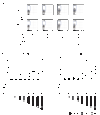Co-engagement of alpha(4)beta(1) integrin (VLA-4) and CD4 or CD8 is necessary to induce maximal Erk1/2 phosphorylation and cytokine production in human T cells
- PMID: 19815047
- PMCID: PMC2795106
- DOI: 10.1016/j.humimm.2009.09.360
Co-engagement of alpha(4)beta(1) integrin (VLA-4) and CD4 or CD8 is necessary to induce maximal Erk1/2 phosphorylation and cytokine production in human T cells
Abstract
The alpha(4)beta(1) integrin VLA-4 (very-late activation antigen-4) and the lineage-specific CD4 and CD8 receptors have been proposed as putative co-stimulatory receptors on T cells. To assess the relative contribution of signaling through the TCR, CD28 and these accessory molecules, we activated human T cells using soluble antibodies recognizing all four of these T-cell receptor classes (CD3, CD28, CD4/CD8, and VLA-4), and we assessed the degree of activation using higher-order flow cytometry detecting intracellular Erk1/2 phosphorylation and production of IL-2 and IFN-gamma. We found that: (1) co-stimulation via CD4/CD8, in addition to CD28, is required for optimal T-cell activation; (2) VLA-4 binding consistently potentiates CD4(+) and CD8(+) T-cell activation; (3) augmentation of T-cell activation through VLA-4 binding is most pronounced following engagement of CD4/CD8. These results confirm that multiple signals, including VLA-4 engagement, are necessary for maximal T-cell activation beyond that induced via the TCR and CD28.
Figures



Similar articles
-
Defective integration of activating signals derived from the T cell receptor (TCR) and costimulatory molecules in both CD4+ and CD8+ T lymphocytes of common variable immunodeficiency (CVID) patients.Clin Exp Immunol. 1997 Nov;110(2):174-81. doi: 10.1111/j.1365-2249.1997.tb08314.x. Clin Exp Immunol. 1997. PMID: 9367399 Free PMC article.
-
4-1BB ligand induces cell division, sustains survival, and enhances effector function of CD4 and CD8 T cells with similar efficacy.J Immunol. 2001 Aug 1;167(3):1313-24. doi: 10.4049/jimmunol.167.3.1313. J Immunol. 2001. PMID: 11466348
-
CD8+ cells and not CD4+ T cells are hyporesponsive to CD28- and CD40L-mediated activation in HIV-infected subjects.Clin Exp Immunol. 1997 Mar;107(3):440-7. doi: 10.1046/j.1365-2249.1997.d01-964.x. Clin Exp Immunol. 1997. PMID: 9067514 Free PMC article.
-
Expression of costimulatory molecules (CD80, CD86, CD28, CD152), accessory molecules (TCR alphabeta, TCR gammadelta) and T cell lineage molecules (CD4+, CD8+) in PBMC of leprosy patients using Mycobacterium leprae antigen (MLCWA) with murabutide and T cell peptide of Trat protein.Int Immunopharmacol. 2004 Jan;4(1):1-14. doi: 10.1016/j.intimp.2003.09.001. Int Immunopharmacol. 2004. PMID: 14975355
-
CD28(-) T cells: their role in the age-associated decline of immune function.Trends Immunol. 2009 Jul;30(7):306-12. doi: 10.1016/j.it.2009.03.013. Epub 2009 Jun 18. Trends Immunol. 2009. PMID: 19540809 Free PMC article. Review.
Cited by
-
The evolving art of hematopoietic stem cell transplantation: translational research in post-transplant immune reconstitution and immunosuppression.Immunol Res. 2013 Dec;57(1-3):140-50. doi: 10.1007/s12026-013-8461-4. Immunol Res. 2013. PMID: 24242818 Review.
-
Integrin Activation Controls Regulatory T Cell-Mediated Peripheral Tolerance.J Immunol. 2018 Jun 15;200(12):4012-4023. doi: 10.4049/jimmunol.1800112. Epub 2018 Apr 27. J Immunol. 2018. PMID: 29703862 Free PMC article.
-
The impact of lymphocytosis and CD4/CD8 ratio on the anti-JCV antibody index and clinical data in patients treated with natalizumab.Neurol Sci. 2021 Jul;42(7):2847-2853. doi: 10.1007/s10072-020-04897-2. Epub 2020 Nov 17. Neurol Sci. 2021. PMID: 33201361
-
Natalizumab exerts direct signaling capacity and supports a pro-inflammatory phenotype in some patients with multiple sclerosis.PLoS One. 2012;7(12):e52208. doi: 10.1371/journal.pone.0052208. Epub 2012 Dec 20. PLoS One. 2012. PMID: 23284936 Free PMC article.
-
Memory T cells in organ transplantation: progress and challenges.Nat Rev Nephrol. 2016 Jun;12(6):339-47. doi: 10.1038/nrneph.2016.9. Epub 2016 Feb 29. Nat Rev Nephrol. 2016. PMID: 26923209 Free PMC article. Review.
References
-
- Dustin ML, Shaw AS. Costimulation: building an immunological synapse. Science. 1999;283(5402):649. - PubMed
-
- Ledbetter JA, Imboden JB, Schieven GL, Grosmaire LS, Rabinovitch PS, Lindsten T, Thompson CB, June CH. CD28 ligation in T-cell activation: evidence for two signal transduction pathways. Blood. 1990;75(7):1531. - PubMed
-
- Haughn L, Gratton S, Caron L, Sekaly RP, Veillette A, Julius M: Association of tyrosine kinase p56lck with CD4 inhibits the induction of growth through the alpha beta T-cell receptor. Nature. 1992;358(6384):328. - PubMed
Publication types
MeSH terms
Substances
Grants and funding
LinkOut - more resources
Full Text Sources
Research Materials
Miscellaneous

